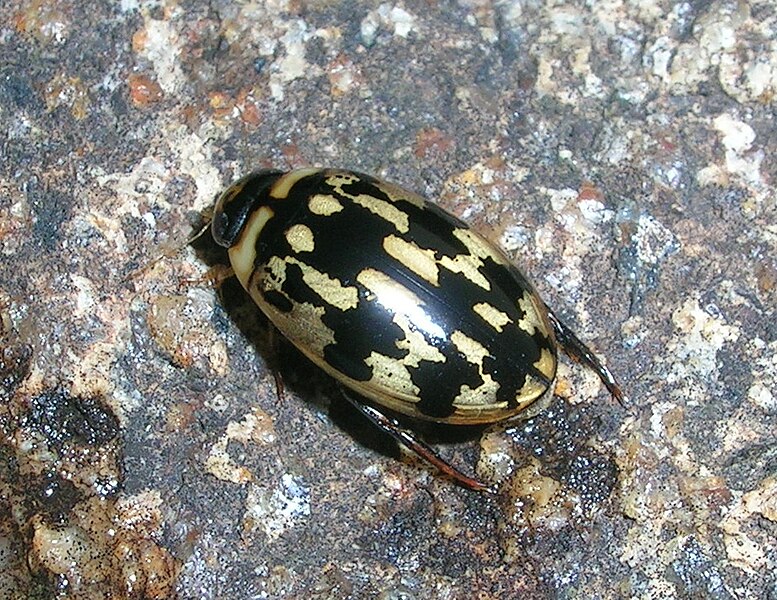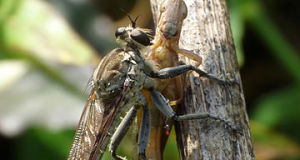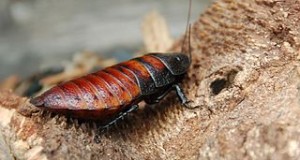 Please see Part I of this article for information on the natural history of the Sunburst or Marbled Diving Beetle (Thermonectes marmoratus), the Green Diving Beetle (Thermonectes sp.) and related insects. These wonderfully interesting aquatic beetles sometimes appear in the pet trade, and they and related species are also rather easy to collect. Today we’ll take a look at their captive husbandry.
Please see Part I of this article for information on the natural history of the Sunburst or Marbled Diving Beetle (Thermonectes marmoratus), the Green Diving Beetle (Thermonectes sp.) and related insects. These wonderfully interesting aquatic beetles sometimes appear in the pet trade, and they and related species are also rather easy to collect. Today we’ll take a look at their captive husbandry.
Habitat
The beetle aquarium should be tightly covered, as all species can and do fly, especially at night. The tank should be stocked with a variety of live aquatic plants (i.e. Elodea, Anachris, Water Hyacinth) and sticks…despite being strong swimmers, Diving Beetles need to take frequent breaks by clinging to submerged objects; egg deposition occurs on live plants.
Water movement should be mild, as most species are adapted to ponds and sluggish streams, and cannot abide strong currents.
Light, Heat and Water Quality
UVB light is not known to be essential but, as these insects are diurnal residents of shallow waters, UVA light may be important in regulating activity and perhaps breeding behavior.
Temperatures of 70-82 F are well-tolerated.
Diving Beetles inhabit waters that are often subject to widely varying pH and ammonia levels. However, they are best kept in stable environments where ammonia levels are kept low and pH remains between 6.8 and 7.5.

Feeding
These ravenous little beasts readily accept crickets, crushed waxworms, earthworm pieces, brine shrimp, blackworms and bits of prawn and fish; most take tropical fish flakes and freeze-dried foods as well.
Social Grouping/Compatible Species
Marbled and Green Diving Beetles will get along with others of their kind and with robust aquatic insects such as Whirligig Beetles and Backswimmers. They will be attacked and consumed by Giant Water Bugs and their relatives.
Except for the largest species, most Diving Beetles do not molest fishes. However, even peaceful fishes such as Fathead Minnows will out-compete the Diving Beetles for food. Also, many aquatic insects use a radar-like system to detect fishes (which are major predators) and may therefore be stressed by the presence of even non-predacious species.
Diving Beetles may be housed with snails, crayfish and larger freshwater shrimp.
Captive Longevity
Adults may reach 2-3 years of age.
Breeding
Both Sunburst and Green Diving Beetles deposit eggs on live plants.
A dip in temperature and shortened light cycle for 4-6 weeks may stimulate reproduction, but is not absolutely necessary. Some have reported consistent breeding following a “drought/rain cycle” (water level is dropped for 2 weeks, temperature is raised 5 F, then tank is re-filled with water that is cooler by 10 degrees F than ambient).
Once the larvae reach a length of 1 inch or so, they should be provided with easy access to a container of damp earth for pupation.
Caution!
As is true of nearly all aquatic insects, Diving Beetles can bite – hard!
Diving Beetles fly well and will unerringly locate the tiniest of openings about filter tubes and electrical wires – all such areas should be sealed with tape.
Further Reading
Diving Beetle natural history information can be found here.
This video illustrates why Diving Beetle larvae are known as “Water Tigers”.
Diving Beetle image referenced from wikipedia and originally posted by L Shyamal
 That Reptile Blog – Reptile, Amphibian and Exotic Pet Care and Information
That Reptile Blog – Reptile, Amphibian and Exotic Pet Care and Information



Thanks for the tips! Just got a couple of these little sunbursts 😀
Hello Elaine, Frank Indiviglio here.
Thanks for the feedback; enjoy and please let me know how they do.
Please let me know if you need any further information. Good luck, enjoy and please keep me posted.
Best regards, Frank Indiviglio.
Hey Frank, I know this is a bit of an old article, but I recently began keeping a few of my local diving beetles, and this was very helpful. Also, I was looking around a vernal pool nearby, and I was surprised to find a pair of giant water scavenger beetles (Hydrophilus sp.) and I just had to add them to my aquarium. However, I don’t know a whole lot about their care; is it relatively similar to that of the diving beetles? Could most of the stuff in this article apply to them, or do they require special care? I thought that if anyone knew, it would by you. By the way, thanks for making such great articles; they are all very interesting and informative.
Hello Satchell
Thanks for your interest and the kind words; much appreciated. Great to hear that you are keeping native insects…most get so little attention from private keepers and zoos.
Very interesting to receive your note…here in NY, I also often come across water scavenger beetles in vernal ponds in early spring; the adults hibernate and seem to become active before most others. They can be kept as described in the article; room temperatures are fine. Mine have done fine with similarly-sized hard-bodied beetles and true bugs, but they may attack smaller insects. Keep some floating plants or reed stems in the tank, as the eggs are attached to floating plant material.
Please keep me updated when you have a chance,
Please let me know if you need any further information. Good luck, enjoy and please keep me posted.
Best regards, Frank Indiviglio.
I want to say, yes they do bite hard! I found one in the bottom of a boat while fishing. I had never been able to look closely at one and so took the opportunity. I picked it up and was looking at it when I got bit. It was like the worst wasp sting ever times two. My finger went numb after the bite. I will never handle one with my bare hands again. They are beautiful but beware.
Hi Neil,
Thanks for the observation; the venom that they and other aquatic insects injects is quite powerful, and very surprising as you’ve seen!…allows them to overcome large prey, incl fish and tadpoles. Best, Frank
Hey frank, I’ve been wondering, how do you care for whirlegig beetles, the ones that spin and float at the top of the water?
Hi Jordan,
Fascinating insects…but ignored, you’re the only one of thousands of readers to have asked! I kept 100 or so in a large zoo exhibit housing turtles, water snakes…drew more attention than “main” exhibit animals. Eyes split to see above/below water, very unique structures.
They are simple to keep..fly at night so must be covered. Feed readily on tropical fish food flakes, and attack small crickets and such like a pack of mini-wolves. Some deposit eggs on land, I believe, others in reed stems. The larvae are grub-like, aquatic and carnivorous. Hope you decide to keep them next season, best, Frank
Hi Mr. Indiviglio,
I love your articles and plan to continue reading more.
Maybe you can help me, we have a swimming pool in Florida being converted into a natural pool and I find that the little mosquito fish (gambia) are overpopulated and I think we should eliminate them. Would a diving beetle predate them, or would they get attached by the fish (they themselves are kind of aggressive). I want to eliminate them naturally as food for something, but I’m not ready to put a bluegill or bass fish in there yet. Any ideas?
Viv Z
Hello Vivian,
Thanks for the kind words. In such situations it’s very rare for a predator to be able to control a fast-breeding species; some diving beetles, giant water bugs etc will take fish when possible,. but it’s not a major food item and the would not be able to make a dent. Minnow traps would be your best option. Please keep me posted, frank